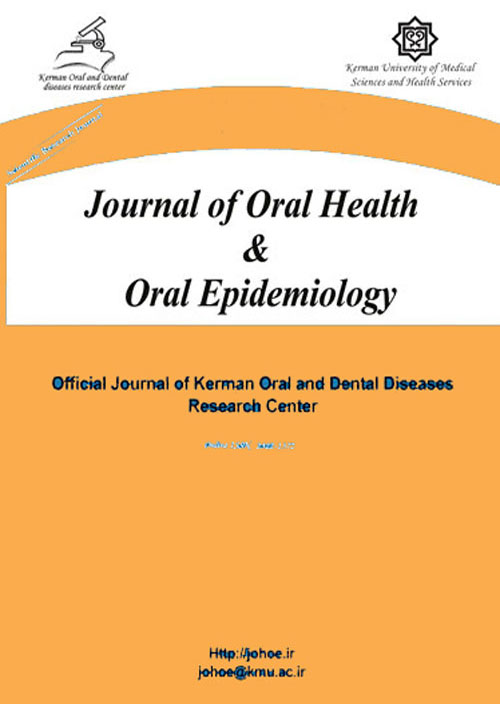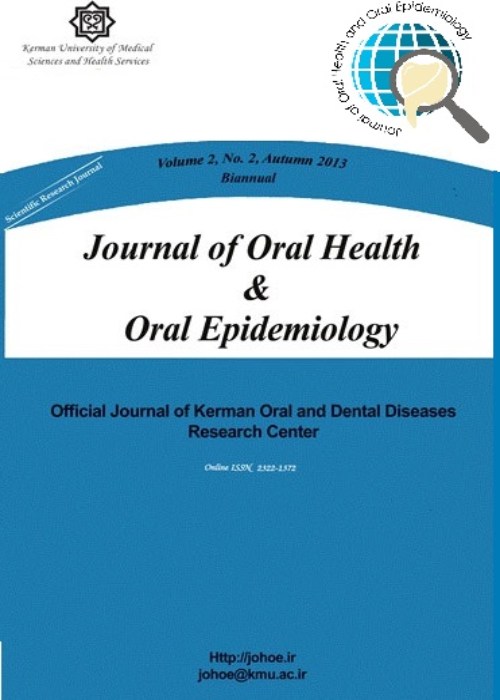فهرست مطالب

Journal of Oral Health and Oral Epidemiology
Volume:9 Issue: 4, Autumn 2020
- تاریخ انتشار: 1399/09/03
- تعداد عناوین: 8
-
-
Pages 162-167BACKGROUND AND AIMThis study is conducted aiming to assess and compare the salivary levels of malondialdehyde (MDA) and lactate dehydrogenase (LDH) in active and passive smokers to determine the correlation between environmental tobacco smoke and health condition.METHODSThis study evaluated 75 healthy individuals including 25 active smokers, 25 passive smokers, and 25 non-smokers with an equal percentage of males and females. Unstimulated saliva samples were collected from all participants. The salivary level of cotinine was first measured for correct allocation of participants to the aforementioned three groups using enzyme-linked immunosorbent assay (ELISA) technique. The salivary levels of MDA and LDH were then measured.RESULTSThe salivary level of cotinine was 19.1, 8.12, and 3.36 nmol/ml in active smokers, passive smokers, and non-smokers, respectively. The salivary level of MDA was 4.78, 2.67, and 2.63 nmol/ml while the salivary level of LDH was 508.33, 364.98, and 271.63 nmol/ml in active smokers, passive smokers, and non-smokers, in the order given.CONCLUSIONAcceding to the results, the salivary levels of cotinine, MDA, and LDH had significant correlations with cigarette smoking. The salivary levels of MDA and LDH were significantly higher in active smokers than passive smokers, and also the values in passive smokers were higher than the corresponding values in non-smokers (P < 0.05).Keywords: Malondialdehyde, Lactate Dehydrogenase, Smokers, passive smoking, Saliva
-
Salivary thiocyanate levels among tobacco users, non-users, and passive smokers: A biochemical studyPages 168-172BACKGROUND AND AIM
The prevalence of tobacco use and its associated mortality is increasing worldwide. Biomarkers in saliva, such as thiocyanate levels, have been shown to be a suitable indicator for smoking. The present study is conducted to determine the thiocyanate levels in saliva and compare them among tobacco (smoking and smokeless) users, passive smokers, and non-smokers.
METHODSA cross-sectional comparative study was conducted on 100 patients attending a dental college in South India. The patients were inquired about their tobacco habits and were divided into 4 groups: smokers (25), passive smokers (25), smokeless tobacco users (25), non-users (25). Saliva samples were collected from subjects in sterile containers, and thiocyanate levels were estimated. The results were tabulated and analyzed using SPSS software. Kruskal-Wallis test was used for the intergroup comparison of salivary thiocyanate levels. Mann-Whitney U test was used for the pairwise group comparison. If P < 0.0500, the results were reported to be statistically significant.
RESULTSThe results of the study showed that the salivary thiocyanate level was 79.46 ± 7.80, 50.16 ± 6.87, 50.16 ± 13.83, and 36.61 ± 5.84 mmol/l among smokers, passive smokers, smokeless tobacco users, and non-users, respectively. There was a statistically significant difference in salivary thiocyanate levels among various groups (P ≤ 0.0001). All pairwise comparisons showed statistical significance (P ≤ 0.0001) except the comparison between the passive smokers and smokeless tobacco users groups (P ≤ 0.9200).
CONCLUSIONSalivary thiocyanate may be a diagnostic biomarker for differentiating tobacco users from the non-users.
Keywords: Saliva, thiocyanate, smoking, Tobacco, Tobacco Smoke Pollution -
Pages 173-179BACKGROUND AND AIM
Oral health literacy (OHL) has proved to be important in diminishing oral health inequalities and in promoting oral health. The aim of this study was to evaluate the correlation between OHL and dental indices of 12- to 15-year-old students in Ahvaz, Iran.
METHODSIn this cross-sectional study, a sample of 254 middle school students was selected by cluster random sampling method. The data were gathered using a previously-validated questionnaire, Oral Health Literacy Instrument (OHLI). Oral health status was evaluated using the Simplified Oral Hygiene Index (OHI-S) and the Decayed, Missing, and Filled Teeth (DMFT) index. Data were analyzed using SPSS software with a significance level of P < 0.05.
RESULTSFrom a total of254 students (mean age = 13.65 years, 51.57% male),24.4% were caries-free. The OHL level of 50.2% of the students was inadequate and it was in positive correlation with the OHI-S, students’ gender, grade, and their fathers’ educational level (P < 0.05). The mean DMFT of the sample was 3.35 ± 2.72 and it was significantly higher among girls (P = 0.004). The mean OHI-S was 1.24 ± 0.91.
CONCLUSIONAccording to our findings, students with higher OHL had better oral hygiene status and belonged to higher educated families. OHL-promoting programs for the students should be considered to improve their oral health and prevent future dental caries.
Keywords: Health literacy, Health Status, mouth, DMF Index, Dental Caries -
Pages 180-186BACKGROUND AND AIMOral health literacy (OHL) and oral health-related quality of life (OHRQOL) are two important current scales for oral health. The aim of the present study was to investigate the correlation between these two scales and explore the Station of clinical indices for dental caries and periodontal disease in this association.METHODSA total of 470 subjects were included in the present study. A total of 51 (10.58%) subjects filled the questionnaire incompletely; therefore, finally, the data of 419 questionnaires were analyzed. Volunteer patients attending dental clinics in Kerman, Iran, enrolled in the study. Data were collected via Oral Health Literacy Adult Questionnaire (OHL-AQ) for OHL, Oral Health Impact Profile (OHIP-14) for OHRQOL, and calculation of Decayed, Missing, and Filled Teeth (DMFT) and Community Periodontal Index (CPI) after clinical examination. The questionnaires were standardized in Persian and their validity and reliability were confirmed. The association of OHL with OHRQOL, CPI, and DMFT was quantified using Pearson’s correlation coefficient.RESULTSFinally, 419 participants enrolled in the investigation. Reported OHL was poor (48.92%) and the score was 9.23 ± 3.39 (the overall score range of the questionnaire was 0-17). The OHIP-14 mean score was 10.10 ± 8.20 (the score range of the OHIP-14 questionnaire was 0-56) There was no significant association between OHL and OHRQOL; however, there was a relationship between DMFT and CPI (P < 0.001).CONCLUSIONIn this sample, we did not find a correlation between OHL and OHRQOL. However, considerable low OHL in this study denotes to necessary take care of.Keywords: Oral Health, Quality of Life, Literacy
-
Pages 187-195BACKGROUND AND AIMCoronavirus disease 2019 (COVID-19) has caused widespread public health concerns and has recently been declared a pandemic by the World Health Organization (WHO). Understanding behavioral responses and other precautionary behaviors related to the pandemic may help to improve public oral health behavior and information about community health risks. Studies are largely reliant on the monitoring of COVID-19 outcomes in clinical settings and health behavior responses to pandemics, but no research has sought to examine how individuals’ oral health behaviors are affected during the pandemic. In this context, the aim of this research is to determine whether Turkish individuals’ oral health behaviors changed during the pandemic.METHODSThis population-based study was conducted in Usak, Turkey. A representative sample of individuals were recruited through three stage cluster sampling multistage cluster sampling method. It was designed to assess the public’s oral health response during the COVID-19 pandemic by using a three-part online questionnaire that contained 15 questions. The first part measured demographic data, the second part identified oral health behaviors, and the last part evaluated precautionary behaviors.RESULTSA total of 2589 individuals, 1584 (61.2%) women and 1005 (38.8%) men were included.The rate of individuals who brushed their teeth twice or more daily before the COVID-19 pandemic was 41.0%, and this proportion increased to 48.4% during the pandemic. The frequency of toothbrushing increased significantly during the pandemic (P < 0.05, chi-square test). A total of 600 (58.1%) smokers decreased smoking per day during the pandemic.CONCLUSIONWithin the limitations of this study, our results suggest that the COVID-19 pandemic is associated with beneficial changes in toothbrushing and smoking behaviors.Keywords: COVID-19, Oral Health, toothbrushing
-
Pages 196-202BackgroundThere is no study on respiratory or cardiac function of mandibular deficient patients before or after treatment. This preliminary trial was conducted for the first time to assess respiratory/cardiac parameters of such patients before and after treatment (compared to healthy controls) with a removable functional appliance.Materials and MethodsThis before-after clinical trial was performed on 20 patients with Class II division 1 malocclusion (mandibular deficiency with normal maxilla) and 20 matched control subjects at the peak of the mandibular growth spurt. Bionator removable functional appliance was used for 9 months to treat Class II cases. Capnography and pulse oximetry were used to record respiratory parameters (end-tidal carbon dioxide (PETCO2)), respiration rate (RR), oxygen saturation (SPO2), and pulse rate (PR)). Groups were compared using paired and unpaired t tests (α=0.05).ResultsCO2 and O2 did not change significantly after treatment (P>0.5, paired t-test). However, respiratory rate and pulse rate reduced significantly after the treatment (P0.1). O2 in healthy subjects was not different from pre-treatment or post-treatment values in Cl II patients (P>0.2, independent-samples t-test). The respiratory rate in healthy controls differed from pre-treatment (PKeywords: Respiratory function tests, Heart Function Tests, Functional Appliance, Orthodontics, Corrective, Quality of Life
-
Pages 203-208BACKGROUND AND AIMThe aim of this study was to investigate the causes and patterns of permanent tooth extraction among a subpopulation of 9-15-year-old Turkish children.METHODSThis study employed a retrospective design and consisted of a total of 198 children aged 9 to 15 years attending a dental faculty between January and December 2019. The clinical and radiographic data were obtained from the medical and dental forms from the faculty database. The inclusion criteria included having at least one permanent tooth loss. Age, gender, the Decayed, Missing, and Filled Teeth (DMFT) scores, type and localization of missing permanent tooth/teeth, and reasons for the loss were evalauted. The data were analyzed using descriptive statistics and chi-square test at 0.05 significance level.RESULTSA total of 198 patients with 309 extracted teeth were evalauted. The mean age of the subjects was 12.95 ± 1.58 years and mean DMFT score was 6.25 ± 3.52. Extractions for orthodontic needs (41.7%) and caries-related extractions (32.4%) were the most common causes of tooth loss followed by unsuccessful dental treatments in 13.9% of cases. While the highest DMFT scores were found in dental caries and orthodonic needs groups, the less scores were found in the “others” group. The most frequently extracted teeth due to caries were the first molar teeth and the first mandibular molars were mostly extracted compared to maxillar first molars. The most frequently extracted teeth due to orthodontic needs and dental caries were seen in girls.CONCLUSIONOrthodontic needs and dental caries were found to be the main causative factors for permanent tooth extractions.Keywords: Child, Dental Caries, Tooth, Tooth loss
-
Pages 209-215BACKGROUND AND AIM
Waterpipe smoking causes many negative side effects on the oral health. Our objective was to describe the prevalence of waterpipe smoking and awareness of related orodental complications in Iranian university students.
METHODSThis cross-sectional study was carried out on 384 students of Shahid Bahonar University, Kerman, Iran, studying in Kerman in 2018-2019, who were selected by simple random sampling. The data were collected through a questionnaire containing demographic characteristics, waterpipe smoking information, and 18 questions about awareness of related orodental complications. The data were analyzed by SPSS software, using t-test, Tukey’s test, regression, and analysis of variance (ANOVA) at the significance level of 0.05.
RESULTS184 (48.0%) subjects were men. The mean age of participants and the mean age for beginning waterpipe smoking was 22.10 ± 2.47 and 18.05 ± 2.61 years, respectively. 168 (43.8%) subjects used waterpipe, 105 (62.5%) used waterpipe just for fun, and 120 (71.4%) smoked the waterpipe in cafes. The mean score of their awareness was 10.47 ± 4.45 out of 18. The ranking of the scores in terms of awareness was good (33.4%), moderate (45.4%), and poor (19.3%). There was a significant relationship between gender, marital status (men and married subjects had more knowledge), lack of waterpipe smoking, and awareness.
CONCLUSIONWaterpipe smoking among the students was relatively high, and the awareness of the negative influences of waterpipe on oral health was moderate. The awareness of students concerning the consequences of waterpipe smoking on oral health should be taken into consideration emphatically.
Keywords: Water pipe smoking, Cigarette smoking, Oral Health, Students, awareness


